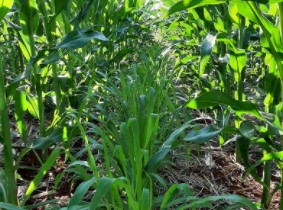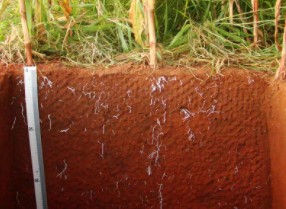By Kaine Korzekwa
The old adage “variety is the spice of life” can also be true on the farm. Planting the same crop over and over, year after year, can quickly deplete the soil of valuable nutrients. The crops eventually won’t produce as much, and the farmer will lose profits.

Maize can be intercropped with brachiaria ruziziensis in the second crop to improve the soil in the field. Intercropping means growing two different crops on the field at the same time.
Switching up the crops planted is a farming practice used in areas across the world. Researchers in Brazil wanted to test crop diversification practices to help their farmers produce more and grow their profits. Tiago Santos Telles, a scientist at the Instituto Agronômico do Paraná (IAPAR) in Brazil, led the economic research.
In Brazil, the warmer weather allows for more than one harvest during the year. There is a summer crop, which is usually soybeans in Brazil. Then there is another crop grown in autumn-winter, commonly corn or wheat.
The researchers tested different autumn-winter crops over a period of six years. They took numerous measurements, such as crop yield, operating costs, and profit for each production model they tested.
“Soybean has been grown in crop systems with low crop diversity in Brazil,” Santos Telles says. “However, these models are becoming less efficient and sustainable. Our study helped identify that more diverse crop systems can have better economic results than those with less diversity.”

Maize usually has smaller root systems that aren’t the most beneficial for the soil. When intercropped with brachiaria ruziziensis, there is better distribution, quantity, and deepening of roots in the soil profile.
Their work found two different options that could improve profits for farmers and also not require changes in machinery or labor by farmers. One option is replacing the second crop of corn with a grass called brachiaria ruziziensis every three years. Another is intercropping second crop corn with the grass. Intercropping is a practice of growing two crops in a field at the same time, usually alternating the rows.
The addition of this grass is essential to helping the health of the soil for many reasons. It does not compete with other crops. By covering the soil, the grass can reduce the growth of weeds, many of which are resistant to herbicides. It also prevents water from evaporating too quickly and soil and nutrients from running off the field.
More moisture and better temperatures also make the soil a friendlier place for beneficial microorganisms to live. The large root systems of the grass help absorb nutrients in the field and improve the structure of the soil.
“Originating in Africa, the grass was introduced in Brazil for use in feeding livestock,” explains Santos Telles. “It has high palatability and is recommended in the breeding and fattening phases of cattle. This grass is one of the most used species in no-tillage systems and is intercropped with other crops.”
Click here to see more...